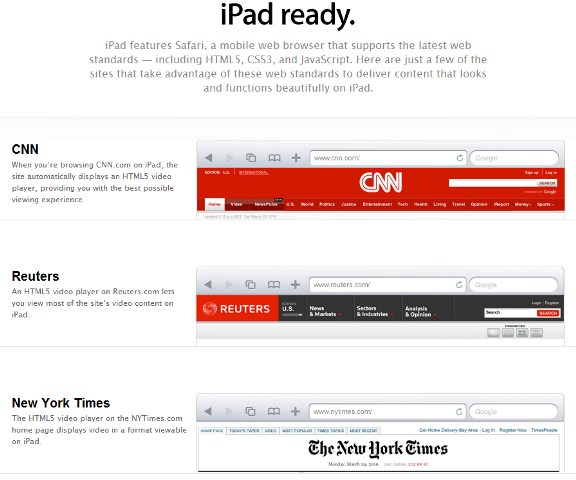Will popular websites, especially those from news and entertainment companies, work on the iPad? Apple, in an arguably brilliant PR effort now has an answer: an online collection of iPad-Ready sites.

The Cupertino-based maker of iPods and iPhones made a bold, potentially Internet-changing decision when it decided that the upcoming slate computer known as the Apple iPad would not support Adobe Flash technology. This browser plugin, used across the Web for everything from streaming video to casual games, is slowly being phased out by HTML5, the next revision of the core markup language used in the creation of Web pages. The video support included in the upcoming Web standard requires no downloadable, installable plugin in order to work. But HMTL5 is still new, and details – including what video codec it will support – have not been ironed out.
Apple’s New “iPad-Ready” Collection
Initially spotted by the eagle-eye bloggers at The Next Web, the new “iPad Ready” resource available at www.apple.com/ipad/ready-for-ipad is a collection of websites that now officially work on the iPad.
According to the site’s description, this collection includes websites that take advantage of standards like HTML5, CSS3 and JavaScript. In other words, these are sites that have been designed just for the millions of new iPad owners expected to be online by the end of the first quarter this year.
Included in the list are CNN, Reuters, New York Times, Vimeo, Time, Major League Baseball, The White House, Virgin America, Sports Illustrated, Flickr, People Magazine and TED. Site owners who want their website listed can use the included submission form to be added to the list. Also, at the bottom of the page, there’s a link to the Safari Technical Library documentation detailing how to get your Web content ready for the iPad.

Flash vs. HTML5: Did Apple Make this a War?
This “iPad Ready” site’s launch seems all the more relevant in light of yesterday’s news from Apple’s newest rival Google: the Internet giant announced it would begin integrating Flash into its Web browser Google Chrome. Was that a shot at Apple? Or was Google genuinely interested in making Web browsing less complex for everyday users?
It’s a valid question. The debate about Flash’s future on the Internet is so hotly charged at the moment, that even WSJ reporter Walt Mossberg seemed afraid go into detail in his otherwise stellar, in-depth iPad review. The only mention he made was this: “I probably used the laptops about 20% as often as normal, reserving them mainly for writing or editing longer documents, or viewing Web videos in Adobe’s Flash technology, which the iPad doesn’t support, despite its wide popularity online.”
Perhaps he honestly doesn’t think the iPad’s inability to display Flash content will be an issue…and maybe it won’t be. But to ignore the burning question that many soon-to-be iPad owners have – that is: will my favorite websites work? – seems like an oversight at best.
These days, the Flash vs. HTML5 discussion is being framed as a “war” (and if you read through the comments of a post detailing video performance test results, you would think it certainly is). But the truth is, HTML5 isn’t displacing Adobe Flash anytime soon. It likely will…eventually…but that day is years away. This is according to Brightcove CEO Jeremy Allaire, whose company is helping website owners prepare for iPad. The issue, said Allaire, is that the percentage of Web browsers that support HTML5 is “tiny,” and those that do so haven’t yet settled on one video codec as the default. Until there’s uniformity in the implementation of HTML5 video, he said, publishers will offer multiple versions of their websites, dependent on what device, browser and operating system is in use by their website visitors.
So in the meantime, that means desktop Web surfers will see Flash, iPad Web surfers will see HTML5 on some sites and the “Flash broken blue lego” elsewhere. Even if that’s the case, it won’t, in the end, take away from the iPad’s relevance in the new age of touch-based computing. It will just be a temporary setback until the rest of the Internet catches up with its own future.
Don’t miss the ReadWriteWeb Mobile Summit on May 7th in Mountain View, California! We’re at a key point in the history of mobile computing right now – we hope you’ll join us, and a group of the most innovative leaders in the mobile industry, to discuss it.










